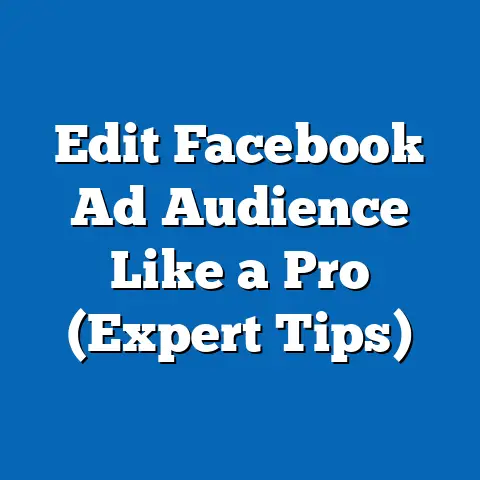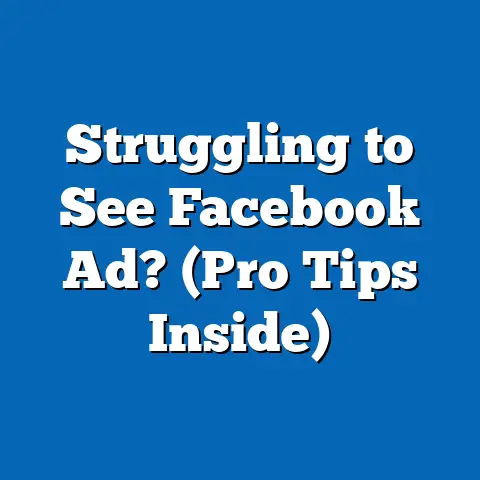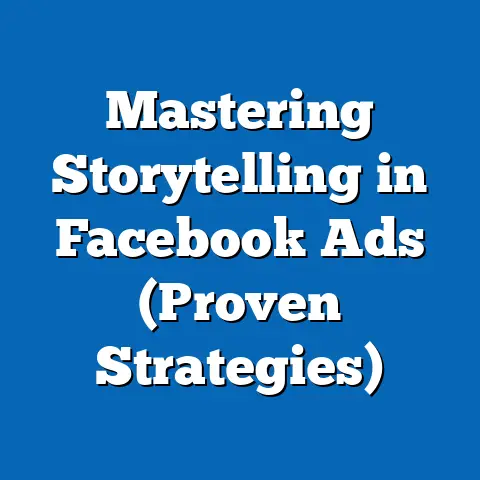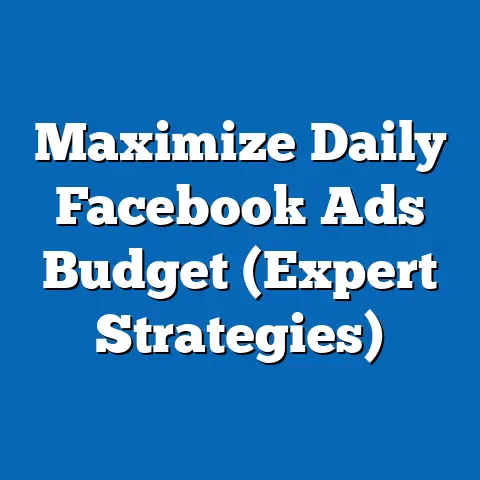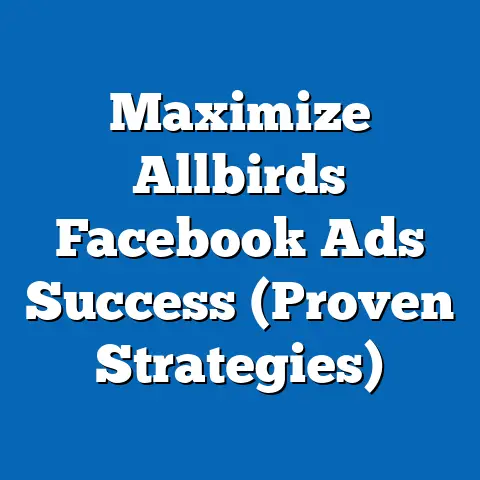Master Facebook & Instagram Ad Targeting (Pro Techniques)
In today’s hyper-connected world, digital advertising has become the cornerstone of marketing strategies, with platforms like Facebook and Instagram leading the charge. As of 2023, Meta (the parent company of both platforms) reported over 3.96 billion monthly active users across its family of apps, with advertising revenue reaching $114.4 billion in 2022 alone, according to Meta’s annual financial report. This staggering figure underscores the immense potential of ad targeting, a technique that allows businesses to reach specific audiences with unparalleled precision, driving engagement, conversions, and return on investment (ROI).
Targeted advertising on these platforms isn’t just about reaching more people—it’s about reaching the right people. Research from eMarketer indicates that 74% of marketers consider targeted ads more effective than traditional advertising, with conversion rates improving by as much as 200% when ads are personalized to user demographics and behaviors. This article delves into the professional techniques for mastering ad targeting on Facebook and Instagram, exploring demographic trends, historical shifts, and actionable strategies grounded in data.
Section 1: The Role of Comfort in Digital Advertising
Why Comfort Matters in Ad Targeting
In the realm of digital marketing, “comfort” refers to the alignment between an ad’s content, tone, and delivery and the user’s expectations, preferences, and cultural context. When users encounter ads that resonate with their interests or reflect their lived experiences, they are more likely to engage. A 2022 study by Nielsen found that 68% of consumers are more likely to trust brands that deliver personalized content, highlighting the importance of comfort as a driver of ad success.
Comfort isn’t just a feel-good factor; it directly impacts key performance indicators (KPIs) like click-through rates (CTR) and conversion rates. For instance, ads tailored to specific demographics—such as age, gender, or location—can achieve CTRs up to 2.5 times higher than non-targeted campaigns, according to data from WordStream.
Statistical Trends in Comfort-Driven Advertising
Recent data reveals a growing emphasis on comfort in ad targeting strategies. According to a 2023 report by Statista, 81% of global marketers prioritize personalization in their social media campaigns, with a particular focus on cultural relevance and localized messaging. This trend is especially pronounced on platforms like Facebook and Instagram, where users spend an average of 33 minutes and 30 minutes per day, respectively, per Pew Research Center’s 2023 findings.
Moreover, comfort-driven targeting has led to a 30% increase in ad engagement rates over the past five years, as reported by Hootsuite’s 2023 Social Media Trends Report. This surge is attributed to advancements in machine learning algorithms that analyze user behavior and preferences to deliver hyper-relevant content.
Section 2: Demographic Breakdowns in Ad Targeting
Age-Based Targeting: Generational Preferences
Demographic targeting remains a cornerstone of effective advertising on Facebook and Instagram, with age being one of the most critical factors. As of 2023, users aged 25-34 constitute the largest demographic on both platforms, accounting for 29.6% of Facebook’s user base and 31.2% of Instagram’s, according to Statista. This group is often targeted for products related to career development, travel, and technology, as they represent a high-earning, decision-making segment.
Conversely, younger users (18-24) are more prevalent on Instagram, making up 24.5% of its audience compared to 18.1% on Facebook. This demographic responds well to visually driven campaigns, with Instagram Reels and Stories achieving 22% higher engagement rates among Gen Z users, per a 2023 report by Sprout Social. Older users (35-54), who form 26.3% of Facebook’s audience, tend to engage more with long-form content and ads for family-oriented or household products.
Gender and Cultural Nuances
Gender-based targeting also plays a pivotal role in crafting comfortable ad experiences. Women make up 44.2% of Facebook’s global user base and 48.7% of Instagram’s, with men accounting for the remainder, as per DataReportal’s 2023 Digital Report. Women are more likely to engage with ads related to fashion, beauty, and wellness, with a 15% higher CTR in these categories compared to men, according to WordStream data.
Cultural context further shapes targeting strategies. For instance, ads tailored to regional holidays or local languages see a 35% increase in engagement in markets like India and Brazil, where cultural diversity is significant, per a 2022 Meta Advertising Insights report. Marketers must prioritize comfort by aligning campaigns with cultural norms to avoid alienating potential customers.
Geographic and Socioeconomic Targeting
Location-based targeting is another powerful tool, especially for businesses with physical storefronts or region-specific offerings. In 2023, 70% of small businesses using Facebook Ads leveraged geo-targeting to reach local audiences, resulting in a 40% increase in foot traffic, according to a study by GWI. Urban users, who represent 55% of Instagram’s user base, are more likely to engage with trendy, lifestyle-focused ads, while rural users (20% of the audience) respond better to practical, value-driven messaging.
Socioeconomic factors also influence ad performance. High-income users (earning above $75,000 annually) are 18% more likely to convert on luxury goods ads, while middle-income users ($30,000-$75,000) show a preference for discounts and promotions, per eMarketer’s 2023 Consumer Behavior Report. Tailoring ad copy and visuals to reflect these economic realities enhances user comfort and drives results.
Section 3: Historical Trends in Ad Targeting (2010-2023)
The Evolution of Targeting Capabilities
When Facebook Ads launched in 2007, targeting options were rudimentary, limited to basic demographics like age, gender, and location. By 2010, the platform had introduced interest-based targeting, allowing advertisers to reach users based on their likes and hobbies. This marked a significant shift, with early adopters reporting a 50% increase in ad relevance scores, according to a 2011 study by SocialBakers.
Instagram, launched in 2010, initially focused on organic content but rolled out advertising in 2013 with similar demographic targeting options. By 2015, both platforms had integrated behavioral targeting, leveraging user activity (e.g., browsing history, app usage) to refine ad delivery. This led to a 120% surge in ad revenue for Meta between 2015 and 2017, per the company’s financial statements.
Privacy Regulations and Their Impact
The late 2010s brought significant changes with the introduction of privacy regulations like the General Data Protection Regulation (GDPR) in 2018 and the California Consumer Privacy Act (CCPA) in 2020. These laws restricted data collection practices, forcing platforms to pivot toward first-party data and contextual targeting. Engagement rates dipped temporarily by 8% in 2018-2019 as advertisers adapted, per eMarketer data, but recovered as Meta introduced tools like Custom Audiences and Lookalike Audiences to maintain precision without violating privacy norms.
Historically, ad targeting has also shifted from broad reach to hyper-personalization. In 2010, only 20% of ads on Facebook were personalized; by 2023, this figure soared to 85%, driven by AI and machine learning advancements, according to Statista. This evolution underscores the growing importance of comfort, as users increasingly expect ads to feel relevant rather than intrusive.
Section 4: Pro Techniques for Mastering Ad Targeting
1. Leverage Custom Audiences for Precision
Custom Audiences allow advertisers to target users based on existing customer data, such as email lists or website visitors. This technique boosts comfort by ensuring ads reach individuals already familiar with a brand. Meta reports that campaigns using Custom Audiences achieve a 37% higher conversion rate compared to generic demographic targeting.
To implement this, upload customer data to Meta Ads Manager and create segments based on purchase history or engagement level. For instance, retargeting users who abandoned their carts with a 10% discount can increase conversions by 25%, per a 2022 Shopify study.
2. Utilize Lookalike Audiences for Expansion
Lookalike Audiences help advertisers reach new users who share characteristics with their best customers. By analyzing traits like demographics, interests, and behaviors, Meta’s algorithm identifies similar profiles, expanding reach without sacrificing relevance. Campaigns using Lookalike Audiences see a 30% lower cost-per-acquisition (CPA) on average, according to WordStream’s 2023 data.
For optimal results, start with a high-value seed audience (e.g., past buyers) and narrow the audience size to 1-2% of the target market for maximum similarity. This ensures the algorithm prioritizes quality over quantity, enhancing user comfort through relevant messaging.
3. Optimize for Dynamic Creative
Dynamic Creative automatically tests multiple combinations of ad elements (e.g., images, headlines, CTAs) to identify the most effective version for each user. This technique aligns with comfort by delivering personalized content without manual intervention. Meta’s 2023 data shows that Dynamic Creative campaigns achieve a 24% higher CTR compared to static ads.
To execute this, provide at least 5-10 variations of each ad component and let the algorithm optimize over a 7-14 day period. Focus on visuals and messaging that reflect demographic preferences, such as vibrant imagery for Gen Z or professional tones for older audiences.
4. Harness Advanced Behavioral Targeting
Behavioral targeting analyzes user actions—such as search history, app usage, and purchase intent—to deliver timely ads. For example, targeting users who recently searched for “running shoes” with a sports apparel ad can increase relevance by 40%, per a 2022 Google-Meta joint study. This method enhances comfort by aligning ads with users’ immediate needs.
Use Meta’s Pixel and Events Manager to track behaviors like page views or add-to-cart actions. Combine this with interest targeting to create layered audiences, ensuring ads feel both relevant and non-intrusive.
5. Test and Iterate with A/B Testing
A/B testing is critical for understanding what resonates with different demographics. By testing variables like ad copy, visuals, or placement, marketers can refine campaigns to maximize comfort and engagement. Data from HubSpot indicates that A/B testing can improve conversion rates by up to 20%.
Run tests with small budgets initially, focusing on one variable at a time (e.g., headline A vs. headline B). Analyze results using Meta’s Ads Reporting tool and scale the winning variant, ensuring continuous optimization.
Section 5: Statistical Comparisons Across Demographics
Engagement Rates by Age and Platform
Engagement varies significantly across age groups and platforms. On Instagram, users aged 18-24 have an average engagement rate of 4.2%, compared to 2.8% for 25-34-year-olds, per Sprout Social’s 2023 data. On Facebook, however, engagement peaks at 3.5% for the 35-44 age group, reflecting their preference for detailed content over quick visuals.
These differences highlight the need for platform-specific strategies. Younger audiences on Instagram respond to short, trendy formats like Reels, while older Facebook users favor informative posts and videos.
Conversion Rates by Gender and Income
Conversion rates also differ by demographic. Women convert at a rate of 3.1% on wellness and beauty ads, compared to 1.9% for men, according to eMarketer’s 2023 report. High-income users ($75,000+) show a 4.5% conversion rate on premium products, nearly double the 2.3% rate for middle-income users ($30,000-$75,000).
These disparities emphasize the importance of tailoring ad budgets and messaging. Allocating more spend to high-converting segments while offering value-driven promotions to price-sensitive groups can optimize ROI.
Section 6: Future Projections and Implications
The Rise of AI-Driven Targeting
Looking ahead, AI and machine learning will continue to redefine ad targeting. By 2025, 90% of digital ads are expected to leverage AI for personalization, per a 2023 Gartner forecast. This will further enhance comfort, as algorithms become better at predicting user preferences and delivering relevant content in real time.
Meta is already investing heavily in AI, with tools like Advantage+ automating audience selection and creative optimization. Marketers who adopt these technologies early can expect a 15-20% reduction in CPA by 2026, according to eMarketer projections.
Privacy and Ethical Considerations
Privacy will remain a key concern, with stricter regulations likely to emerge by 2025. Apple’s iOS tracking changes in 2021 already reduced ad effectiveness for 30% of Meta advertisers, per a 2022 Forbes report. Future policies may push platforms toward zero-party data (user-provided information) and contextual targeting, requiring marketers to balance precision with ethical practices.
Brands that prioritize transparency—such as disclosing data usage in ad copy—can build trust and maintain user comfort. A 2023 Nielsen survey found that 62% of consumers are more likely to engage with brands that openly address privacy concerns.
Emerging Demographics and Markets
Finally, emerging markets like Africa and Southeast Asia will drive user growth for Facebook and Instagram, with projections estimating a 25% increase in users from these regions by 2027, per Statista. These demographics, often younger and mobile-first, will require culturally relevant, low-bandwidth content to ensure comfort and engagement.
Marketers should prepare by investing in localized campaigns and mobile-optimized formats. Partnerships with regional influencers can also boost credibility, with 45% of users in these markets citing influencer recommendations as a key purchase driver, per a 2023 GWI report.
Conclusion: Crafting Comfortable, High-Impact Campaigns
Mastering ad targeting on Facebook and Instagram is both an art and a science, requiring a deep understanding of demographics, historical trends, and cutting-edge techniques. By prioritizing comfort—through personalized messaging, cultural relevance, and ethical data practices—marketers can build trust and drive meaningful results. The data is clear: targeted ads outperform generic campaigns by wide margins, with engagement rates, CTRs, and conversions all benefiting from precision.
As we look to the future, the interplay of AI, privacy regulations, and emerging markets will shape the next era of digital advertising. Marketers who adapt to these changes while maintaining a user-centric approach will not only survive but thrive in an increasingly competitive landscape. With the right strategies, tools, and insights, mastering ad targeting is within reach—unlocking the full potential of Meta’s powerful platforms.

